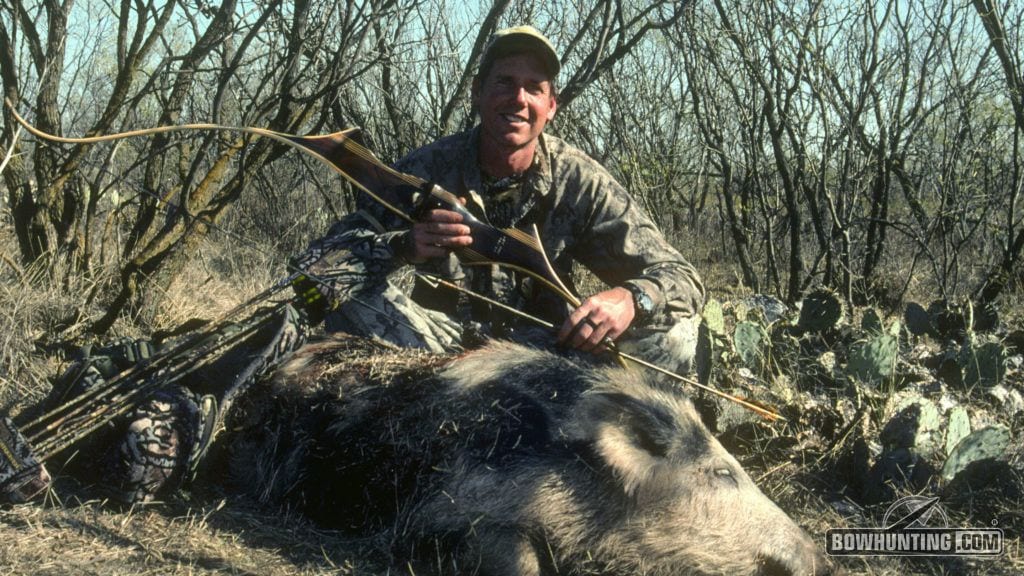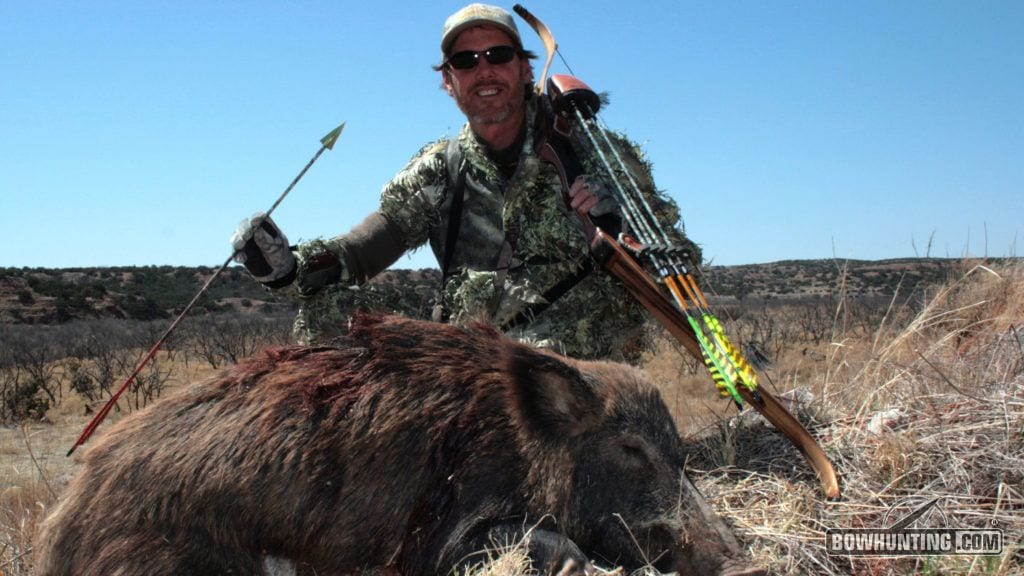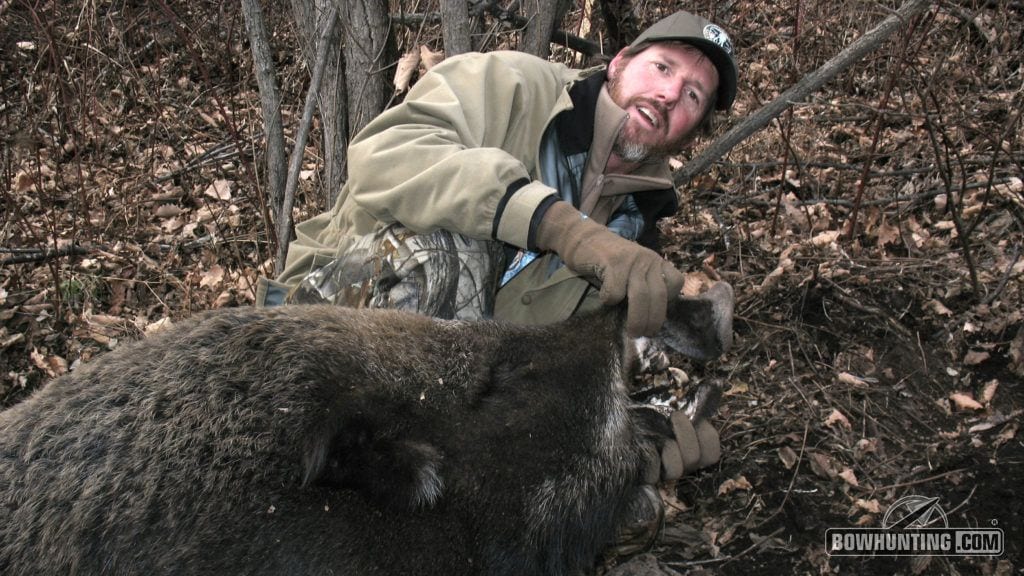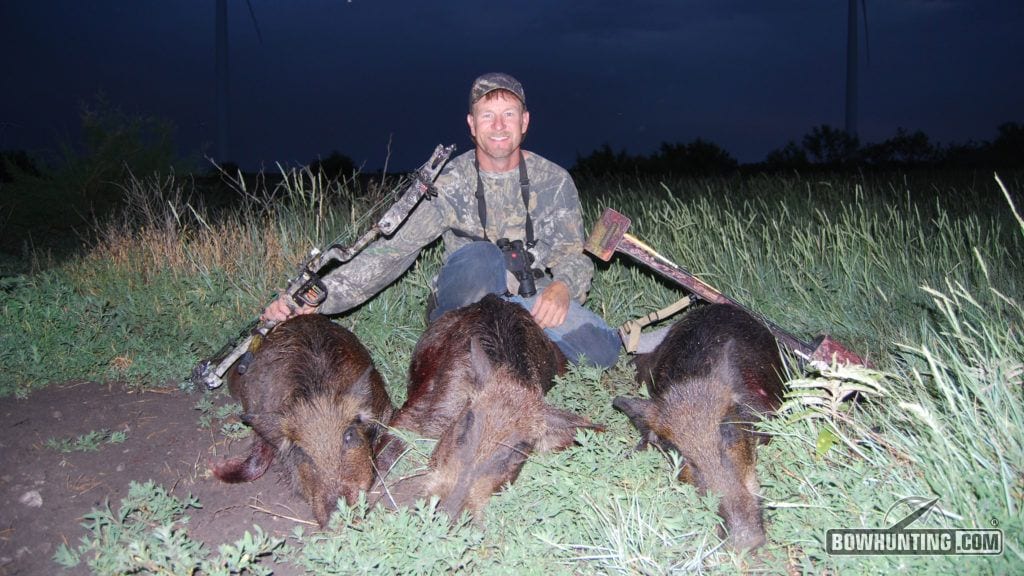Wild boar hunting is more popular than ever, which has led to some interesting misperceptions. Here are some wild hog myths busted.
While it’s safe to say most farmers, landowners and wildlife managers loathe invasive feral hogs, I must admit I love them. I’m a hard-core bowhunter, after all, and nothing is more fun to pursue with bow and arrows than wild boar. They’re super abundant in a wide variety of locations and habitats, don’t involve the strict rules and bag limits of more popular big game animals, and also so happen to be extremely good to eat (the reason they got started in North America to begin with). I have successfully bowhunted them across North America; from Florida to Texas to California and still can’t get enough of them. After arrowing some 100-plus hogs I’ve definitely developed some notions of what is what when it comes to this homely but tasty quarry. I’ve also encountered a lot of silly wives tales pertaining to bowhunting hogs. Here are just a handful of those.

From the flatlands to the high country, hogs can now be found in most states across the U.S.
Myth: Boars Can’t Be Penetrated On Broadisde Shots Because They All Wear A Protective Gristle Shield.
Fact: While it is true many old, warrior boars—and by this I mean old males of the species—develop a gristle shield of tough scar tissue earned through love’s labor’s lost, this really is the exception rather than the rule. Assuming every mature boar has developed such a tough gristle shield is like assuming every mature whitetail buck will grow Boone & Crockett antlers. It’s rare in other words. Some boars are inclined to fighting, others are not. I did once encounter such a boar, a 500-plus-pound Texas boar that made a living killing and eating sheep, but even with the inherently low-energy recurve I was shooting at the time (combined with heavy aluminum shaft and cut-on-contact broadhead) I got enough penetration to find his heart and put him down within 450 yards. He was no doubt extremely tough, but he wasn’t indestructible.
Such a gristle shield, if indeed you encountered a boar large and old enough to have developed one, doesn’t correlate to a knight’s armor. The only problems I can foresee with such a situation is while shooting low energy equipment (compounds less than 60 pounds or traditional gear) in combination with light carbon speed arrows (weighing less than 8.5 gpi) and inefficient broadhead designs, namely wide-cutting mechanicals that chop instead of slice once deployed.
In most other cases the average hogs you’ll encounter in the field—the 90- to 150-pound specimens constituting 98 percent of harvest (which also so happen to represent the best eating)—fall easily to the standard-issue equipment you address white-tailed deer with each fall.
Myth: You Need Heavy-Weight Gear to Tackle Wild Swine.
Fact: I’ve already addressed this above, but I’ll add a couple caveats, just for the sake of argument. In bowhunting we generally prepare for worst-case scenarios. Many of us regularly shoot more poundage than needed, outfits generating enough kinetic energy to kill Cape buffalo, and broadheads tough enough to take on ¾-inch plywood and cinder blocks without a shrug. Not because we need it, but because we might need it. This is insurance against an accidental shoulder-blade or spine hit, against an animal that jumps the string badly and spins into or away from the shot, requiring our arrows to penetrate more flesh and bone than anticipated when choosing the perfectly broadside or slightly-quartering shot.
In hog hunting, worst case might sometimes be translated into best case, in this instance encountering one of those rare behemoth boars out during legal shooting light (or maybe taken over bait during nighttime hours with artificial light, which is legal in states like Texas). In this case you don’t really need a bow with excessive draw weight. Just change your arrow and broadhead combination, shoot the gear you already have set up, and you’re good to go on the biggest boars. This means a sturdy carbon arrow weighing more than 10 gpi (preferably a slim shaft, like Easton’s Deep Six FMJ—11 gpi—or Carbon Express’ PileDriver PTX—10.32 gpi and also carrying a solid-steel insert—as examples) and true cut-on-contact broadhead (like Muzzy’s Phantom SC or Steel Force’s Phathead, as examples).

A good cut-on-contact broadhead is hard to beat on hogs of any size.
Myth: Wild Boar Are Dangerous Game on Par With Grizzly Bears.
Fact: This notion makes for dramatic magazine headlines and helps inflate the egos of outdoor writers. Of all the wild hogs I’ve dealt with, only one charged and inflicted any serious damage, and that one was a very big, very old boar being molested by hounds. The other 99 or so I’ve killed with various weapons, couldn’t get away fast enough.
Now, this isn’t to say you should take undue chances with feral hogs, as even domesticated farm-pen hogs have been known to hurt people. In general, don’t corner any wild hog (or any other wild animal for that matter, as even a 20-pound trapped coyote can get downright nasty), especially when they are wounded. Proceed with caution when trailing any wounded hog into tight brush, especially when trailing includes hands-and-knees crawling (a posture making you appear more like another hog than a threatening human). I mean, really, a wounded whitetail buck can prove dangerous, and wild boars do own sharp tusks they use to fight one another for dominance. Always give a wounded boar a way out. Given no other choice they will certainly use those tusks to defend themselves.
Myth: All American Feral Swine Are Descendants of European “Russian” Boars.
Fact: I’ve killed Russian boars, in Russia, and in France, and though those animals resembled feral pigs in many ways they were not to be mistaken with the feral hogs we have in North America—most of which are pure-and-simple escapees from domestic operations. No matter where I’ve hunted wild hogs, there reins a myth of some rich landowner who imported pure Russian boars from Poland or some such place, penned for his private amusement, that subsequently escaped to mix with local populations. When pressed for details these stories become pretty murky. These make for colorful local legend, but I can assure you it has never happened. If you reach back far enough, there might be a touch of wild European blood here and there; just a touch, but I remain doubtful.

The author has hunted hogs across the globe. He’s pictured here with a true Russian boar.
No matter the breed or source, all wild hogs, given a few generations on the loose, eventually revert to some form of primitive lineage, growing long snouts, droopy ears (Russian boar ears are quite small) and a rangy, “razor-back” appearance. They also, sooner or later, begin to transform from recognizable forms into an overall black to grizzly-brown color more closely resembling the bear-like hues of true Russians, perhaps causing some of this confusion. All these traits are formed by mixing breeds, hard living, and often spotty diet. This doesn’t make them any less of a trophy, any less fun to hunt. They’re just not Russians, that’s all.
Myth: Wild Hogs Are Found Only in Hawaii, California, South Texas and Florida.
Fact: While these are certainly wild hog strongholds, I’ve also killed or know people who have killed feral hogs in places such Oklahoma, Arkansas, Mississippi, Georgia, Tennessee and Kentucky, as well as unlikely places such as Kansas, Nebraska, north and southeastern New Mexico and southeastern Idaho, Ohio, and Vermont.
The point here is, today you’re likely to find wild hogs just about anywhere, sometimes fairly close to home. In fact, a recent U.S. Fish & Wildlife Service study reported that established populations of feral hogs are now found in 42 of 50 states. It pays to keep your ears open and eyes peeled. Some of these populations are small and quite isolated; a small group of hogs that escaped captivity and may soon be eradicated. In other places hog populations are quite large but local hunters simply haven’t “discovered” them yet.

Liberal bag limits and quality table fare make hogs one of the best bowhunting opportunities you’ll ever find.
Southeastern New Mexico comes to mind regarding the latter. For years a small but growing population of hogs flourished in the salt cedar jungles along the Pecos River northeast of Roswell. They were largely neglected for years, but are starting to become a welcome source for sport in the area. Hogs from Texas’ Panhandle have slowly migrated up major drainages and into northeastern New Mexico and are now spreading into southern Colorado. Huntable numbers of hogs have appeared in New Mexico’s Boot Heel and Arizona’s southwestern corner, far from traditional populations, and the White Mountains near Ruidoso, New Mexico. I only mention these populations because they are familiar to me and also serve to illustrate the point that wild hogs can show up just about anywhere. If hogs can survive in harsh New Mexico habitats, just imagine what they can accomplish in bountiful oak forests and farmlands of the East.

 By
By 



